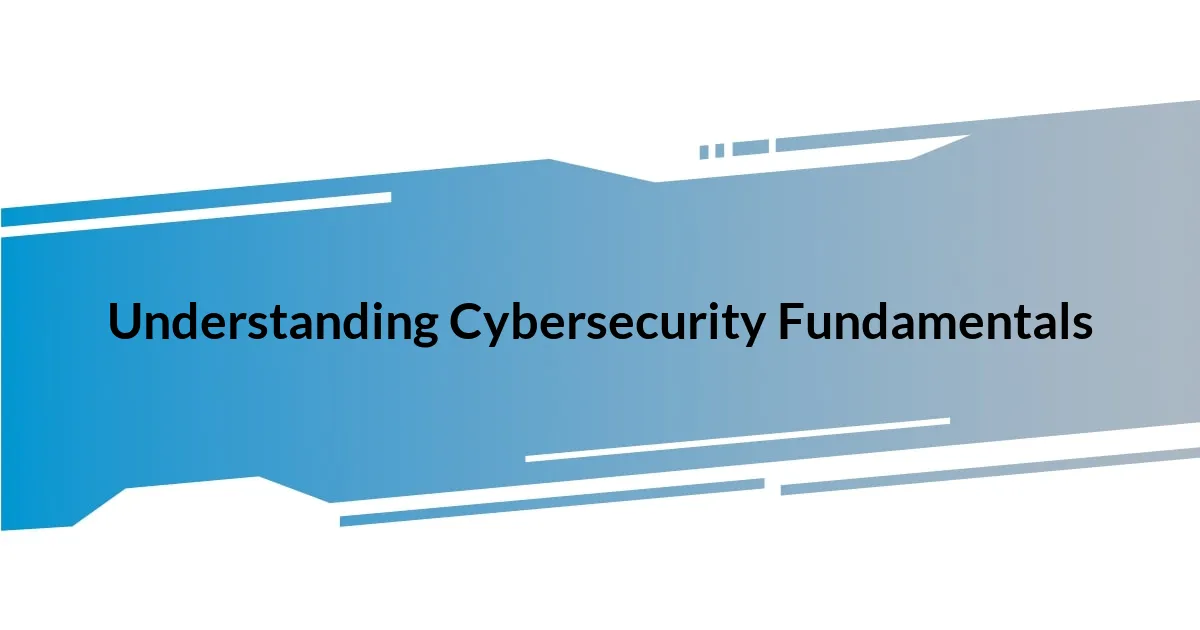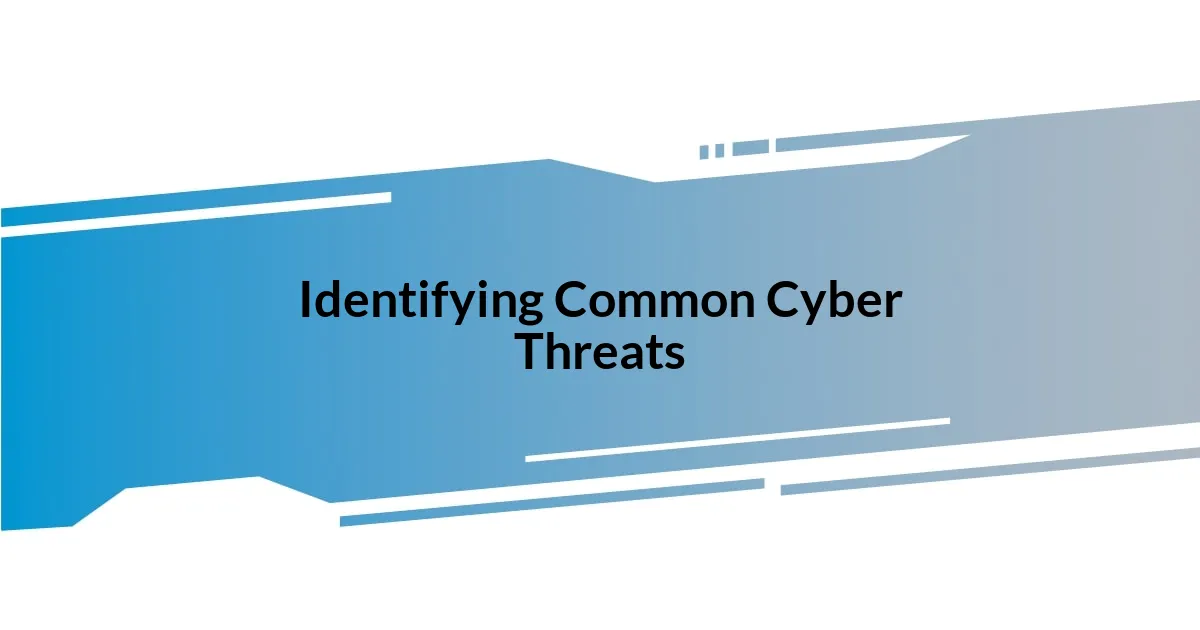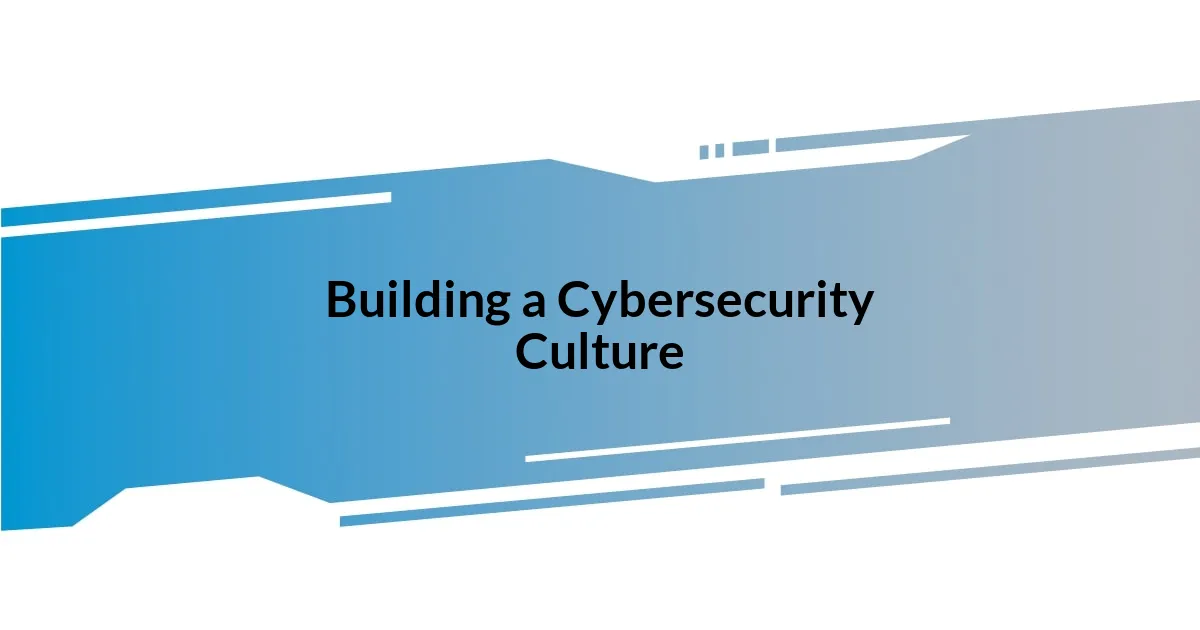Key takeaways:
- The CIA triad (Confidentiality, Integrity, Availability) is fundamental to all cybersecurity strategies, emphasizing the importance of data security.
- Effective cybersecurity training should be tailored to the specific needs and risks of the organization, incorporating various teaching methods to accommodate different learning styles.
- Real-world application of training through simulations and continuous feedback enhances both knowledge retention and behavioral changes in participants.
- Building a cybersecurity culture involves open dialogue, recognizing advocates, and making training engaging through gamification and relatable content.

Understanding Cybersecurity Fundamentals
When I first delved into cybersecurity, the basics felt overwhelming — so many terms and concepts! I remember grappling with the difference between malware and phishing and questioning why anyone would fall for such tricks. It’s fascinating how understanding these threats can truly empower individuals and organizations alike to protect their assets.
One fundamental principle I can’t stress enough is the importance of the CIA triad: Confidentiality, Integrity, and Availability. Imagine a world where your personal information is easily accessible by anyone — it sounds terrifying, doesn’t it? This triad serves as the backbone of all cybersecurity strategies, ensuring that not only is your data secure, but it’s also trusted and accessible when needed.
Reflecting on a training session I conducted, I noticed the real turning point for many participants was when we discussed the concept of a “threat model.” This exercise helped them visualize potential vulnerabilities in their own environments and realize that cybersecurity isn’t just a tech issue; it’s a personal responsibility. Have you ever considered how your daily habits online may expose you to risks? It’s these everyday actions that often determine our security posture.

Identifying Common Cyber Threats
Identifying common cyber threats is crucial for creating effective cybersecurity strategies. I still remember the first time I encountered a phishing email—it looked so genuine that I almost clicked on a malicious link. It was a stark reminder of how sophisticated these attacks can be. Each type of threat has its own tactics and objectives, and knowing them can make all the difference in our defenses.
Here are some prevalent cyber threats to be aware of:
- Phishing: Fraudulent emails designed to trick you into providing sensitive information.
- Malware: Malicious software that can disrupt, damage, or gain unauthorized access to systems.
- Ransomware: A type of malware that locks you out of your files and demands payment for access.
- Denial of Service (DoS): An attack aimed at making a service unavailable by overwhelming it with traffic.
- Insider Threats: Risks posed by individuals within the organization, potentially causing harm either intentionally or accidentally.
Each of these threats embodies a real concern in today’s digital landscape. Just recalling my early experiences makes me realize the need for continuous learning and vigilance.

Developing a Tailored Training Program
Developing a training program tailored to the specific needs of an organization is not a one-size-fits-all task. When I crafted my first cybersecurity training, I took the time to analyze the unique risks that my team faced. It was an eye-opener for me, realizing that understanding the environment and the team’s current knowledge levels could directly influence the effectiveness of the program. By focusing on relevant threats, I encouraged participants to engage more actively, making the learning experience memorable.
Another crucial aspect of creating a tailored program is assessing the learning styles of the participants. During one of my initial sessions, I noticed a mix of visual learners and hands-on doers, leading me to incorporate various teaching methods. For example, I used videos, infographics, and live demonstrations, which transformed the program from dry lectures into an interactive experience. This diverse approach fosters an environment where everyone can grasp the concepts, regardless of their learning preferences.
Finally, continuous feedback is essential in refining the training program. After each session, I encouraged open dialogue, asking participants what resonated with them and what didn’t. This input has been invaluable. It’s fascinating to reflect on how those suggestions led to adjustments that ultimately made the subsequent sessions much more effective. How do you typically gather feedback after a training session? I find that it often reveals surprising insights that enhance future learning experiences.
| Aspect | Consideration |
|---|---|
| Understanding Team Needs | Analyze specific risks to tailor content effectively. |
| Learning Styles | Incorporate various teaching methods for enhanced engagement. |
| Feedback Mechanism | Utilize continuous feedback for ongoing program improvement. |

Implementing Interactive Learning Techniques
In my experience, incorporating gamification into cybersecurity training has proven to be a game changer. I vividly recall a workshop where we turned learning into a competitive challenge. Participants were tasked with identifying and neutralizing simulated threats within a timed environment. The energy in the room was palpable as teams raced against each other, and the laughter mingled with the urgency of the task made the learning process not only informative but genuinely enjoyable.
Another technique that resonates with me is the use of role-playing scenarios. During one session, I had participants act out potential cyber incident responses. Watching them step into different roles, from an IT manager to an end-user, sparked rich discussions about best practices and human errors. It made me realize how powerful empathy is in this context. When participants can visualize themselves in various positions, they are more likely to internalize the consequences of poor cybersecurity practices. Have you ever thought about how often we forget that we are all part of the cybersecurity puzzle?
Lastly, I’ve found that interactive Q&A sessions are essential for fostering an engaging environment. In one particular training, I encouraged attendees to bring their real-life cybersecurity dilemmas to the discussion. It was amazing to see how open they were to sharing their experiences, and it provided a platform for collective problem-solving. By addressing specific issues, we not only heightened awareness but also cultivated a sense of community among participants. This approach turned a typical training session into a collaborative learning experience, and I couldn’t help but feel a surge of connection and support within the group.

Evaluating Training Effectiveness
Evaluating the effectiveness of training is something I take very seriously. From my experience, one key method I use is pre-and post-training assessments. I remember a workshop where I administered a short quiz before and after the session. The results provided a clear picture of how much knowledge the participants had gained. Seeing their progress was incredibly rewarding and reaffirmed the value of what we were teaching.
Another approach I employ is real-world scenario testing. After sessions, I sometimes follow up with simulations mimicking actual cybersecurity threats. I recall a time when a team applied what they learned during a training session to respond to a simulated breach. Witnessing their quick thinking and collaboration was thrilling. It got me thinking: how often do we truly connect training to real-life application? This method not only reinforces knowledge but also highlights areas that might need further attention.
Finally, I find it beneficial to measure behavioral changes over time. I once collaborated with a team that had undergone extensive training, and several months later, I checked in to see how they had applied their learning. Their stories about identifying and reporting phishing emails filled me with pride. It reinforced my belief that effective training is not just about absorbing information; it’s about transforming actions and fostering a culture of awareness. Have you seen similar changes in your own teams?

Continuous Improvement Strategies
To truly foster continuous improvement in cybersecurity training, I find it invaluable to implement regular feedback loops. One time, I introduced an anonymous feedback form after each session, and the insights were eye-opening. Participants often shared their thoughts on what resonated with them or what topics they felt needed more depth, making it clear that including their perspective truly enhances the learning experience. Have you ever realized how often we overlook our audience’s voice?
Additionally, I believe in the power of iterative training sessions. Rather than a one-and-done approach, I’ve structured follow-up workshops that build upon previous classes. For instance, in a recent series, we revisited key concepts while introducing new, relevant challenges. This method not only reinforced their knowledge but also cultivated an environment of continuous learning. It’s inspiring to witness participants grow over time—how have you encouraged ongoing development within your own teams?
Furthermore, I advocate for the integration of up-to-date threat intelligence into training materials. One powerful example from my experience came when I shared a recent ransomware attack case study during a training session. The participants were completely engaged as we discussed the incident’s details and implications. The look in their eyes—their realization that these situations could happen to them—was profound. This experience reinforced my belief that when we align training with current threats, we not only educate but also motivate individuals to take proactive steps. How do you keep your training relevant to today’s fast-evolving cyber landscape?

Building a Cybersecurity Culture
Building a strong cybersecurity culture is about more than mere compliance; it’s a mindset that permeates every level of an organization. I often remember a particular incident when I encouraged an open dialogue during a team meeting about cybersecurity concerns. The room’s energy shifted as participants freely shared their experiences, making it clear that when people feel safe to speak up, they become advocates for security rather than bystanders. Isn’t it fascinating how curiosity can spark a cultural shift?
Another element I emphasize is recognizing and celebrating cybersecurity champions within the team. There was a time when I spotlighted an employee who had successfully reported a significant phishing attempt. The gratitude they felt was palpable, and witnessing their recognition not only motivated them but also inspired others to stay vigilant. Have you thought about how acknowledging proactive behavior can create a ripple effect throughout your organization?
Finally, I believe it’s crucial to make cybersecurity training engaging and relatable. One approach that’s worked wonders for me is incorporating gamification elements into our training sessions. During a recent workshop, we used a quiz-style game where teams competed to identify security best practices. The laughter and excitement? Unmatched. It made me realize that when learning feels like play, it sticks. What creative strategies have you used to make your training more impactful?